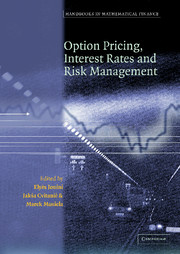17 - Bayesian Adaptive Portfolio Optimization
from Part four - Utility Maximization
Published online by Cambridge University Press: 29 January 2010
Summary
Introduction
This chapter is a contribution to the study of portfolio optimization problems in stochastic control and mathematical finance. Starting with initial capital x0 > 0,an investor tries to maximize his expected utility from terminal wealth, by choosing portfolio strategies based on information about asset-prices in a financial market.The investor cannot observe directly the stock appreciation rates or the driving Brownian motion; he ca only observe past and present stock-prices. We adopt a Bayesian approach, by assuming that the unknown “drift” (i.e., vector of stock appreciation rates) is an unobservable random variable, independent of the driving Brownian motion and with known probability distribution. We refer to this as the case of partial observations, in order to distinguish it from the case of complete observations, on which a large literature already exists.
The original utility maximization problems were introduced by Merton (1971) in the context of constant coefficients, and were treated by the Markovian methods of continuous-time stochastic control; see also Fleming & Rishel (1975), pp. 159–65, Fleming & Soner (1993), Chapter 4, and Karatzas & Shreve (1998), pp. 118–36. For general parameter-processes and complete markets, methodologies based on martingale theory and convex duality were developed by Pliska (1986), by Karatzas, Lehoczky & Shreve (1987), and by Cox & Huang (1989); they were extended to the setting of incomplete and/or general constrained markets by Karatzas, Lehoczky, Shreve & Xu (1991), He & Pearson (1991) and Cvitanić & Karatzas (1992). Chapters 3 and 6 of the monograph by Karatzas & Shreve (1998) contain a comprehensive account and overview of these developments.
- Type
- Chapter
- Information
- Handbooks in Mathematical FinanceOption Pricing, Interest Rates and Risk Management, pp. 632 - 669Publisher: Cambridge University PressPrint publication year: 2001
- 43
- Cited by



